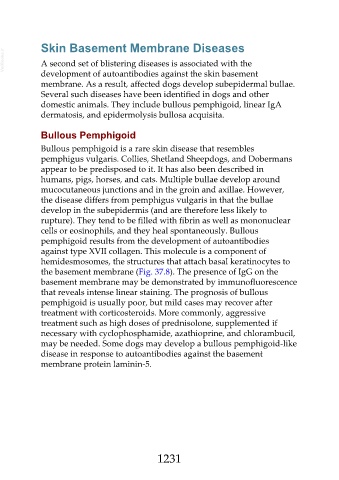Page 1231 - Veterinary Immunology, 10th Edition
P. 1231
Skin Basement Membrane Diseases
VetBooks.ir A second set of blistering diseases is associated with the
development of autoantibodies against the skin basement
membrane. As a result, affected dogs develop subepidermal bullae.
Several such diseases have been identified in dogs and other
domestic animals. They include bullous pemphigoid, linear IgA
dermatosis, and epidermolysis bullosa acquisita.
Bullous Pemphigoid
Bullous pemphigoid is a rare skin disease that resembles
pemphigus vulgaris. Collies, Shetland Sheepdogs, and Dobermans
appear to be predisposed to it. It has also been described in
humans, pigs, horses, and cats. Multiple bullae develop around
mucocutaneous junctions and in the groin and axillae. However,
the disease differs from pemphigus vulgaris in that the bullae
develop in the subepidermis (and are therefore less likely to
rupture). They tend to be filled with fibrin as well as mononuclear
cells or eosinophils, and they heal spontaneously. Bullous
pemphigoid results from the development of autoantibodies
against type XVII collagen. This molecule is a component of
hemidesmosomes, the structures that attach basal keratinocytes to
the basement membrane (Fig. 37.8). The presence of IgG on the
basement membrane may be demonstrated by immunofluorescence
that reveals intense linear staining. The prognosis of bullous
pemphigoid is usually poor, but mild cases may recover after
treatment with corticosteroids. More commonly, aggressive
treatment such as high doses of prednisolone, supplemented if
necessary with cyclophosphamide, azathioprine, and chlorambucil,
may be needed. Some dogs may develop a bullous pemphigoid-like
disease in response to autoantibodies against the basement
membrane protein laminin-5.
1231

